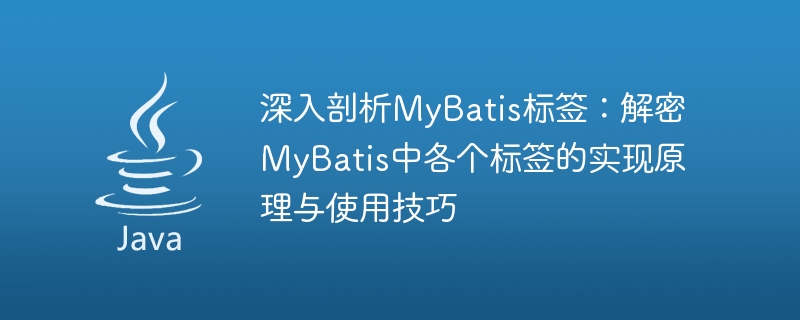

In-depth analysis of MyBatis tags: Decrypting the implementation principles and usage techniques of each tag in MyBatis
MyBatis is a popular Java persistence framework, and its design is inspired by Hibernate and iBatis. MyBatis provides simple and powerful database operation functions by using XML or annotations to configure and map SQL statements. In the configuration file of MyBatis, we can see many tags, which are the key to realizing the functions of MyBatis.
This article will provide an in-depth analysis of the implementation principles and usage techniques of some core tags in MyBatis, along with specific code examples.
The configuration tag is the root tag of the MyBatis configuration file and is used to configure the global settings of MyBatis. In this tab, we can configure data sources, transaction managers, object factories, etc. The following is an example of a configuration tag:
The mapper tag is used to configure the mapping relationship between the mapper interface and the SQL statement. In this tag, we can define the correspondence between the interface method and the SQL statement, and specify the parameters passed to the SQL statement and the results returned from the database through parameter mapping and result mapping. The following is an example of a mapper tag:
The select tag is used to configure query statements. In this tag, we can define the SQL statement and the types of parameters and results used. The following is an example of a select tag:
insert, update and delete tags are used to configure insert, update and delete statements. In these tags, we can define the SQL statement as well as the parameters used and the result type returned. The following is an example of an insert tag:
INSERT INTO users (id, name, age) VALUES (#{id}, #{name}, #{age})
The parameterType attribute is used to specify the type of parameters passed to the SQL statement, and the resultType attribute is used to specify The type of results returned from the database. Here is an example of using the parameterType and resultType attributes:
The sql tag is used to define reusable SQL fragments and the include tag is used for references These SQL snippets. In these tags, we can define a SQL statement and use the include tag to reference it into other SQL statements. The following is an example of sql and include tags:
id, name, age
The above is just a brief introduction to some commonly used tags in MyBatis. In fact, MyBatis has many other tags and functions, such as dynamic SQL, cache configuration, and interceptors. etc. I hope that through the above examples, you can better understand and use the various tags of MyBatis.
To summarize, tags in MyBatis are the key to realizing MyBatis functions. By configuring these tags, we can flexibly map Java objects and database tables to achieve simple and powerful database operations. I hope this article can help you deeply analyze the implementation principles and usage techniques of each MyBatis tag, so that you can use MyBatis with ease.
The above is the detailed content of Explore MyBatis tags: Reveal the implementation principles and application skills of each tag in MyBatis. For more information, please follow other related articles on the PHP Chinese website!
 mybatis first level cache and second level cache
mybatis first level cache and second level cache SQL statement to backup database
SQL statement to backup database What is the difference between ibatis and mybatis
What is the difference between ibatis and mybatis How to configure database connection in mybatis
How to configure database connection in mybatis What is the working principle and process of mybatis
What is the working principle and process of mybatis What are the differences between hibernate and mybatis
What are the differences between hibernate and mybatis currency exchange
currency exchange Stepper motor control method
Stepper motor control method



